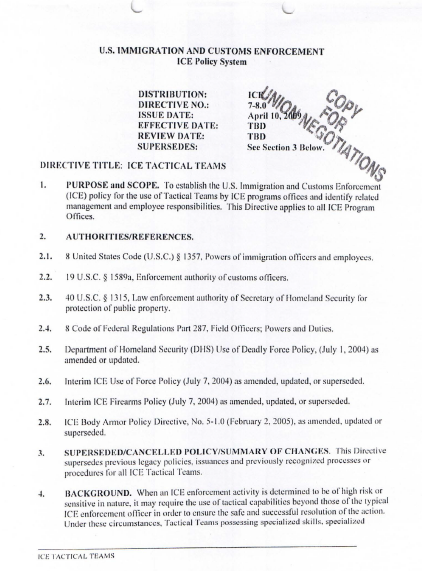ICE TACTICAL TEAMS (Directive 7-8.0)
- 36 pages
- April 10, 2009
- 6.6 MB
BACKGROUND. When an ICE enforcement activity is determined to be of high risk or sensitive in nature. It may require the use of tactical capabilities beyond those of the typical ICE enforcement officer in order to ensure the safe and successful resolution of the action. Under these circumstances, Tactical Teams possessing specialized skills, specialized equipment and specialized training to meet these particular challenges may be required. The deployment of these teams can be viewed as the use of an elevated level of force. For these reasons, it is important for ICE to have processes and procedures for the establishment and operation of these teams, appropriate training and qualification standards for team members, and very specific reporting requirements through defined reporting channels, for team activities.
…
6. POLICY.
6.1. When an ICE enforcement activity is determined to involve high risk or to be sensitive in nature requiring tactical capabilities beyond those of the typical ICE enforcement officer. Program Office Directors may authorize the use of specialized Tactical Teams in order to ensure the safe and successful resolution of the action. It is the policy of ICE to conduct enforcement operations requiring the use of Tactical Teams as safely and professionally as possible.
6.2. Since the deployment of Tactical Teams to perform enforcement actions is considered to be the use of an elevated level of force, the use of Tactical Teams shall be limited to those circumstances where an elevated level of force and visible presence is deemed necessary to safely and effectively complete an enforcement action. The deployment of Tactical Teams shall be made in accordance with the provisions of this Directive and their use in a particular circumstance shall be justified by articulable facts.
…
8.12. Deployment of Tactical Teams.
1) Enforcement Actions involving High Risk Activities.
a) High Risk Activities under Normal Conditions. When requesting the deployment of Tactical Teams during enforcement actions that include high-risk activities, the following procedures shall be followed:
i) ICE agents and officers shall submit a request for the deployment of Tactical Teams through their supervisor to tl1e Tactical Supervisor. This request will include a completed Risk Analysis for Tactical Operations which shall be submitted at least 48 hours prior to any ICE enforcement operation.
ii) The Tactical Supervisor will ensure the accuracy and completeness of the Risk Analysis for Tactical Operations that will be used as a guide in determining the need to use Tactical Team resources.
iii) The requesting officer may be assisted by the Tactical Supervisor or Team Leader in preparing the Risk Analysis for Tactical Operations. The requesting officer or agent most knowledgeable of the situation will be readily accessible to provide the Tactical Supervisor with all relevant infom1ation.
iv) In circumstances where a search or arrest warrant will be executed, the requesting officer or agent will ensure the warrant’s validity and provide copies to the Tactical Supervisor, who will verify the warrant.
v) The Risk Analysis for Tactical Operations will be discussed with the requesting officer’s immediate supervisor and the supervisor of the appropriate Tactical Team. If Tactical Supervisors feel that the request justifies the deployment of the Tactical Team they will forward the request to the Field Responsible Official for their approval and authorization to activate the team.
vi) For the purposes of this Directive, examples of high-risk activities include but arc not limited to, the following situations:
A) A suspect with a history of violence or resisting arrest;
B) Fortified buildings, property, vessels, or other structures or conveyances that require the use of specialized equipment to gain access;
C) Suspects who are members of organizations that advocate violence;
D) Situations that would overwhelm the resources and capabilities of an officer or office with standard equipment and training;
E) A disturbance at an ICE detention facility that poses a risk of physical injury; and
F) Other situations where the totality of circumstances presents an above average risk of danger.

